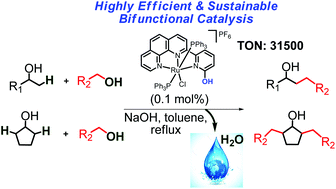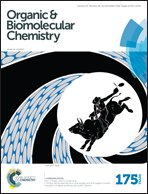Bifunctional Ru(ii) complex catalysed carbon–carbon bond formation: an eco-friendly hydrogen borrowing strategy†
Abstract
The atom economical borrowing hydrogen methodology enables the use of alcohols as alkylating agents for selective C–C bond formation. A bifunctional 2-(2-pyridyl-2-ol)-1,10-phenanthroline (phenpy-OH) based Ru(II) complex (2) was found to be a highly efficient catalyst for the one-pot β-alkylation of secondary alcohols with primary alcohols and double alkylation of cyclopentanol with different primary alcohols. Exploiting the metal–ligand cooperativity in complex 2, several aromatic, aliphatic and heteroatom substituted alcohols were selectively cross-coupled in high yields using significantly low catalyst loading (0.1 mol%). An outer-sphere mechanism is proposed for this system as exogenous PPh3 has no significant effect on the rate of the reaction. Notably, this is a rare one-pot strategy for β-alkylation of secondary alcohols using a bifunctional Ru(II)-complex. Moreover, this atom-economical methodology displayed the highest cumulative turn over frequency (TOF) among all the reported transition metal complexes in cross coupling of alcohols.

- This article is part of the themed collection: New Frontiers in Indian Research

 Please wait while we load your content...
Please wait while we load your content...